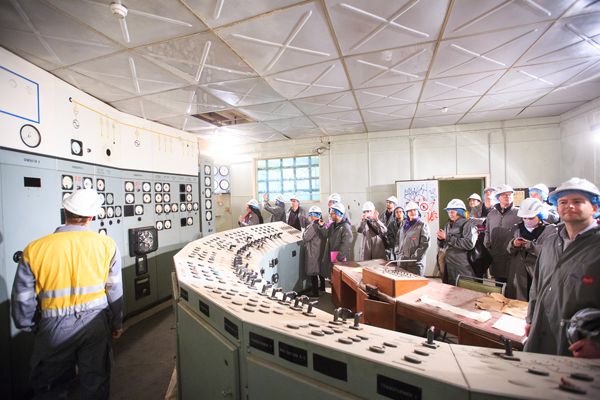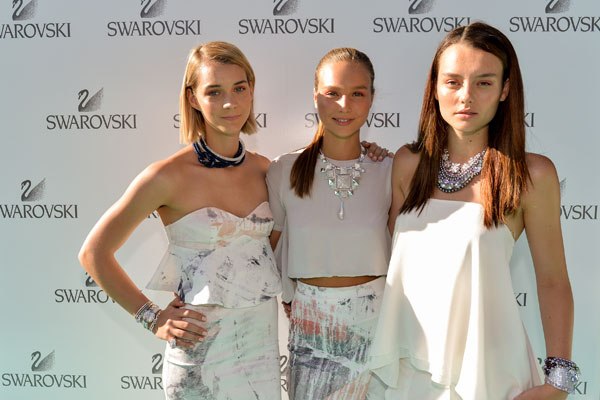Our Melbourne correspondent, Ben Morgan braved Melbourne’s bitter cold at the weekend to file this report on the eighth edition of Open House Melbourne.

July 28th, 2015
Standing in queues on a bitterly cold Melbourne Saturday morning wouldn’t be everyone’s cup of tea. But considering the size of these particular lines, it’s clear that many, many people are excited to be here for the eighth edition of Open House Melbourne.
The first queue I join is one that sees me delve below a street I’ve walked hundreds of times, Russell Place. The Citipower substation, which hums two storeys below street level, is an insight into the infrastructure that keeps Melbourne running. It’s a cavernous space, with huge electrical machinery – very little of the high-tech wizardry you’d expect and much more 1900’s in its aesthetic. It’s certainly an unusual experience.
It’s moments like these that continue, each year, to make Open House Melbourne an engaging experience for hundreds of thousands of visitors over a wintry weekend each July. While there are countless modern buildings to explore – from the towering yet eerily quiet Docklands monoliths of AGL and Medibank, to the Melbourne University Bio 21 building – there seems a fascination with those normally inaccessible or under-publicised buildings and spaces that make up the fabric of the city.
Buildings such as the Mission to Seafarers – with its Spanish-Revival aesthetic and somewhat unremarkable surroundings – Scots’ Church and The State Library of Victoria, are historic living parts of Melbourne, still actively offering respite from the traffic, freeways and seemingly unstoppable urban construction. While buildings such as Forte – a 10-storey LendLease laminated-timber apartment block – offer a glimpse of the future, showing that Melbourne architects and developers are pushing the boundaries of what urban living can be.
But Open House Melbourne goes further than just opening up buildings to the public; through its series of talks, it aims to engage people in a meaningful conversation. The ‘Better Living Forum’ for example welcomed a range of professionals to the stage, including an architect, a developer, an economist and a lawyer, to discuss the Victorian Government’s Better Apartments Discussion Paper. The talk featured an intelligent discussion around the issues facing apartment living in the city, with particularly thoughtful input from Grocon’s David Waldren. The talk highlighted the need for more-considered legislation and social, economic and design-led solutions.
In an ideal world, everyone who attends Open House Melbourne would become more interested in such discourse – and with a developing year-round program Open House is driving the more ‘serious’ design agenda – however for many it simply represents a great day out. But the program undoubtedly casts light on the city’s shadows, with the sole driver being to introduce (and re-introduce) the people of Melbourne to their own buildings and history, and to the architects, designers, organisations and companies who are shaping it.
Every person who discovers a new corner of the city has undoubtedly become more aware and more attentive to the world in which they live. Without such public programs, we could all walk obliviously over the beating hearts of our cities.
Words by Ben Morgan
Open House Melbourne
openhousemelbourne.org
INDESIGN is on instagram
Follow @indesignlive
A searchable and comprehensive guide for specifying leading products and their suppliers
Keep up to date with the latest and greatest from our industry BFF's!

Schneider Electric’s new range are making bulky outlets a thing of the past with the new UNICA X collection.

To honour Chef James Won’s appointment as Gaggenau’s first Malaysian Culinary Partner, we asked the gastronomic luminaire about parallels between Gaggenau’s ethos and his own practice, his multidimensional vision of Modern Malaysian – and how his early experiences of KFC’s accessible, bold flavours influenced his concept of fine dining.

In this candid interview, the culinary mastermind behind Singapore’s Nouri and Appetite talks about food as an act of human connection that transcends borders and accolades, the crucial role of technology in preserving its unifying power, and finding a kindred spirit in Gaggenau’s reverence for tradition and relentless pursuit of innovation.

International fashion powerhouse Swarovski hosted a stunning garden party to celebrate the launch of the houses’ new SS15 collection and the new atelier collection featuring a collaboration with haute couture designer Viktor & Rolf.
The internet never sleeps! Here's the stuff you might have missed

Sofitel Sydney Wentworth gets a facelift, under the deft hand of FK.

Buchan has rewritten the rules on how to design a library, overhauling the traditional interiors and meagre façade, with their iteration of the Biyal-a Armstrong Creek Library.